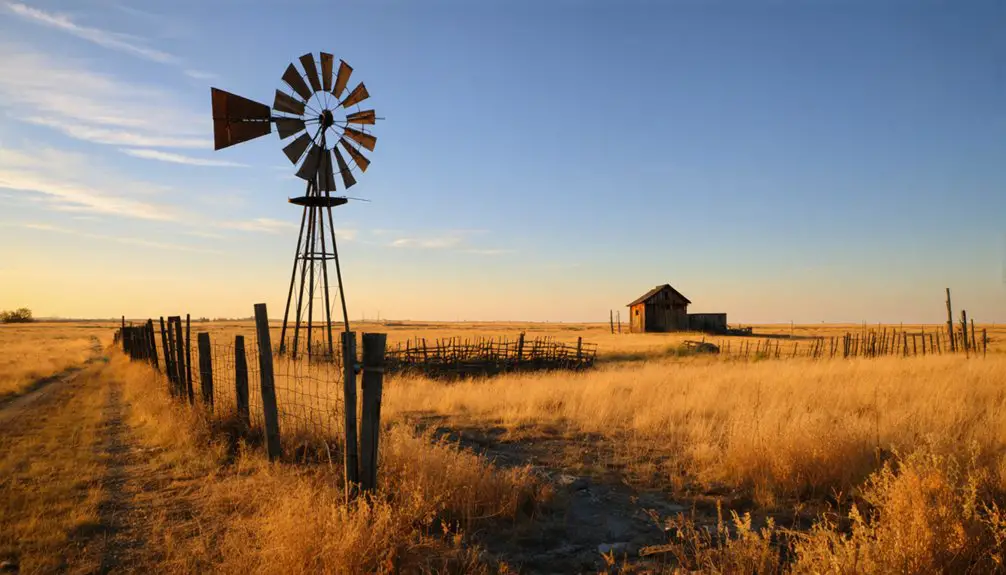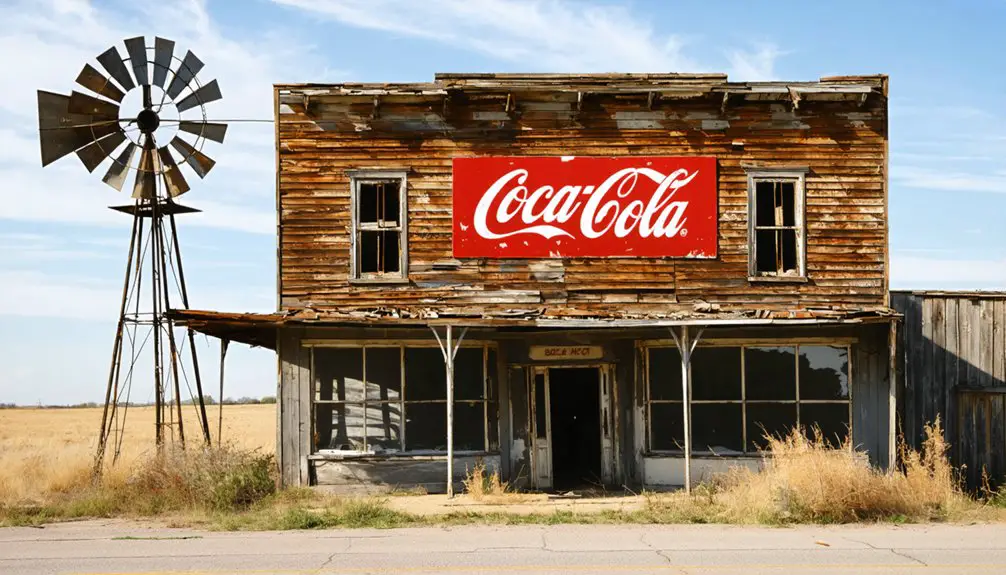You’ll find Aaron, Oklahoma five miles northwest of Olustee, where pioneer Calvin Aaron established this frontier settlement in the late 1800s. The town briefly thrived with its post office (1899-1905) serving as an essential communication hub in Oklahoma Territory. Today, it’s one of Oklahoma’s 2,000 ghost towns, abandoned as residents sought opportunities elsewhere. The site’s coordinates (34°35′35″N, 99°28′26″W) mark a fascinating chapter of territorial expansion and pioneer determination.
Key Takeaways
- Aaron was a late 19th-century settlement in Oklahoma Territory, located 5 miles northwest of Olustee in present-day Jackson County.
- The town was named after Calvin Aaron, an early settler who helped establish the community’s infrastructure and post office.
- The post office operated from 1899 to 1905, serving as the town’s central hub before closing on January 14, 1905.
- Economic decline and population loss occurred as younger residents migrated to urban centers, leading to Aaron’s ghost town status.
- Aaron is situated at 34°35′35″N 99°28′26″W, characterized by rolling prairie and grasslands typical of the Great Plains region.
The Rise and Fall of Aaron
As Oklahoma Territory approached statehood in the late 19th century, the small settlement of Aaron emerged roughly 5 miles northwest of present-day Olustee in Jackson County.
Named after early settler Calvin Aaron, the town dynamics reflected the typical rural development pattern you’d find in territorial Oklahoma, with agriculture and local trade forming the backbone of daily life.
You’ll find that community organization centered around the post office, which operated from January 22, 1899, to January 14, 1905.
While Aaron likely had the usual social institutions of the era, such as churches and schools, the town never developed significant industrial or commercial ventures. Similar to how Levites assisted priests in ancient times, the townspeople worked together to maintain their small community.
Like many Oklahoma communities that became ghost towns due to disasters and urbanization, Aaron’s population dwindled as residents sought opportunities elsewhere.
The closure of the post office in 1905 marked the beginning of Aaron’s decline, and like many similar settlements, it gradually faded into ghost town status.
Life in Early Territory Days
When settlers first arrived in the Territory near Aaron, they encountered a challenging landscape of untamed prairie that demanded tremendous physical labor to transform into productive farmland.
Breaking virgin prairie demanded backbreaking toil as pioneer families fought to carve farmland from the wild Territory landscape.
You’d have faced pioneer hardships like unpredictable weather, grasshopper plagues, and limited water sources while working to establish your homestead. Building homes from prairie sod was common practice for pioneer families establishing their first dwellings.
Daily life meant relying on your neighbors, forging strong community bonds through barn-raisings and shared labor. The Land Rush of 1889 brought approximately 50,000 settlers seeking a fresh start in the territory. You’d have grown corn, cotton, and wheat, while raising livestock to sustain your family.
Getting goods to market proved difficult on dirt roads that turned treacherous in bad weather. The nearest post office, open from 1899 to 1905, served as your lifeline to the outside world.
Basic services were scarce, requiring self-reliance and mutual support among scattered homesteaders to survive.
Calvin Aaron’s Legacy
You’ll find Calvin Aaron‘s most enduring contribution to Oklahoma Territory in the small settlement that took his name during the region’s pioneer development.
His role as an early settler influenced land development patterns typical of late 19th-century Oklahoma, where homesteaders established new communities across the southwestern frontier. Like Moses’s trusted spokesman, he helped guide his people, though in this case toward establishing a new community rather than exodus.
While few physical traces remain of Aaron’s presence today, the ghost town‘s name stands as a symbol of his part in Jackson County’s formative years.
Pioneer Settlement Impact
The pioneering influence of Calvin Aaron, the settlement’s namesake, left an indelible mark on early Oklahoma Territory development.
Similar to the Lovell pioneers and homesteaders, Aaron’s community showed remarkable faith and courage through adversity. You’ll find his legacy woven into the fabric of Jackson County’s evolution, where settler challenges shaped the region’s identity. His presence helped establish essential infrastructure, including the post office that operated from 1899 to 1905.
Aaron’s settlement exemplified community resilience, serving as a significant hub for agricultural development and trade networks.
You can trace how pioneers like Aaron introduced sustainable farming practices for cotton, corn, wheat, and oats, creating a foundation for the area’s economic growth.
Through his efforts, the settlement became a fundamental link in the emerging transportation network that connected remote territories to larger markets, facilitating the region’s progression from frontier to established community.
Early Land Development
During Oklahoma Territory’s transformative period of the 1890s, Calvin Aaron secured his land claim through federal settlement programs that reshaped the region’s frontier landscape.
His commitment to land tenure shaped the area’s early development through:
- Establishing a homestead that met federal requirements for agricultural practices and minimum acreage
- Participating in the region’s emerging ranching economy while managing natural resources
- Contributing to the area’s infrastructure by supporting the establishment of a post office in 1899
You’ll find Aaron’s influence extended beyond basic settlement as he helped transform former Native American territories into agricultural lands. Similar to the establishment of Kingfisher Land Office, his efforts aligned with the systematic organization of land claims in the territory.
His legacy represents the broader shift in land use patterns that characterized southwestern Oklahoma’s development, where settlers balanced farming and ranching to create sustainable communities within the freedom of the open frontier.
Post Office Operations
On January 22, 1899, Aaron’s post office opened its doors, establishing an important communication hub for the fledgling Oklahoma settlement.
You’d find this post office communication center serving as more than just a mail depot – it became the heart of the community, symbolizing federal recognition and permanence for early settlers. The postal service infrastructure provided crucial connections to the outside world through mail delivery and goods distribution. Much like Moses’ spokesman role, the post office served as the town’s voice to the outside world. The establishment reflected a broader pattern of early 1900s development across Osage County’s communities.
However, the town’s promising start wouldn’t last. After just six years of operation, the post office closed on January 14, 1905, signaling Aaron’s decline.
Like many Oklahoma frontier settlements, you could trace the town’s fate through its post office timeline – when postal services ceased, it marked the beginning of Aaron’s shift into ghost town status.
Geographic Location and Landscape

You’ll find Aaron situated in southwestern Oklahoma’s Jackson County, characterized by gently rolling plains and mixed grasslands typical of the region.
The ghost town lies approximately 5 miles northwest of Olustee, positioned at coordinates 34°35′35″N 99°28′26″W in a semi-arid landscape that once supported dryland farming and ranching.
Similar to many abandoned post offices in Oklahoma’s rural regions from the early 1900s, the area experienced significant population decline during periods of economic hardship.
The terrain features relatively flat topography with an elevation between 1,200 and 1,400 feet above sea level, making it representative of Oklahoma’s southern plains environment.
Terrain and Natural Setting
Located at 34°35′35″N latitude and 99°28′26″W longitude in southwestern Oklahoma’s Jackson County, Aaron occupies a characteristic Great Plains setting of gently rolling prairie and grasslands.
The terrain features reflect the region’s natural heritage, with fertile soils supporting both agriculture and ranching across the open landscape.
You’ll find these distinctive elements that shape Aaron’s natural setting:
- Sparse tree cover amid vast expanses of native grasses and hardy shrubs that’ve adapted to the semi-arid climate
- Gently undulating plains formed by ancient erosional processes, underlain by sedimentary deposits
- Sandy loam soils that support dryland farming, while small seasonal creeks provide natural drainage
The area’s natural vegetation thrives in a humid subtropical climate that borders on semi-arid, experiencing hot summers and generally mild winters.
Proximity to Olustee
While Olustee serves as the nearest active settlement to Aaron, the ghost town sits approximately 5 miles northwest at coordinates 34°35′35″N, 99°28′26″W.
You’ll find both locations within Jackson County, Oklahoma, where historical connections between the two settlements shaped early regional development.
Olustee remains an active community along Oklahoma State Highway 6, with 468 residents as of 2020, while Aaron has faded into abandonment.
Though some sources suggest Aaron lies northeast of Olustee, most reliable records place it northwest, about 14 miles from Altus.
The ghost town’s brief operational period from 1899 to 1905 reflects the shifting settlement patterns that defined this area, where smaller communities often declined as nearby towns like Olustee established themselves as enduring population centers.
Factors Behind Town Abandonment
Several interconnected factors contributed to Aaron’s eventual abandonment, reflecting common patterns seen across Oklahoma’s ghost towns.
Economic factors played a decisive role as the town struggled to maintain a sustainable business base, while demographic shifts led to a dwindling population that couldn’t support local services.
A town’s survival hinges on business viability and population stability – without either, local services collapse and communities fade away.
You’ll recognize three key developments that sealed Aaron’s fate:
- The railroad’s diminishing importance reduced traffic through the area, cutting off essential transportation links.
- The closure of crucial businesses and services, including the post office, left residents without basic amenities.
- The migration of younger residents to larger urban centers with better opportunities created an unsustainable population decline.
Like many small Oklahoma communities, Aaron couldn’t adapt to changing economic realities and transportation patterns, leading to its transformation into a ghost town.
Modern-Day Historical Significance

Despite its minimal physical remains, Aaron holds significance as one of Oklahoma’s two thousand ghost towns, offering valuable insights into early settlement patterns and rural development.
When you explore this site today, you’ll find it primarily documented in historical databases and ghost town registries rather than preserved as a tourist destination.
While no formal museums showcase Aaron’s specific story, the town’s brief existence from 1899 to 1905 contributes to our understanding of territorial Oklahoma’s rural landscape.
The site continues to draw interest from ghost town exploration enthusiasts and regional historians who study its connection to early settler Calvin Aaron.
Historical documentation of the town helps preserve the legacy of southwestern Oklahoma’s pioneer settlements, even as physical traces fade into the landscape.
Frequently Asked Questions
What Was the Total Population of Aaron During Its Peak Years?
You’ll find no exact records exist, but considering the town’s brief post office period and population decline patterns, Aaron’s peak years likely saw fewer than 200 residents before 1905.
Were There Any Notable Businesses or Industries Besides the Post Office?
You won’t find records of notable businesses beyond the post office. While there may have been small-scale agricultural developments and local commerce, no significant industries were documented in this short-lived settlement.
Did Any Significant Events or Disasters Contribute to Aaron’s Abandonment?
Like many frontier outposts that vanished into history, you’ll find economic decline was Aaron’s primary downfall. While natural disasters struck Oklahoma, there’s no evidence they specifically caused Aaron’s abandonment.
What Happened to the Original Buildings and Structures of Aaron?
You’ll find most original structures deteriorated naturally after abandonment, with no historical preservation efforts in place. Some buildings were likely dismantled for materials, while others simply collapsed from weather exposure and neglect.
Are There Any Surviving Photographs or Maps of Aaron’s Layout?
You won’t find any confirmed photographs or maps in historical archives. While visual documentation of Oklahoma ghost towns exists, there’s no verified surviving imagery specifically showing Aaron’s original layout.
References
- https://en.wikipedia.org/wiki/Aaron
- https://en.wikipedia.org/wiki/List_of_ghost_towns_in_Oklahoma
- https://www.okhistory.org/publications/enc/entry?entry=GH002
- https://www.wikiwand.com/en/articles/Aaron
- http://genealogytrails.com/oka/garvin/towns.html
- https://echo.snu.edu/the-ghost-towns-of-oklahoma/
- https://www.okhistory.org/publications/enc/entry?entry=SE024
- https://www.ebsco.com/research-starters/history/history-oklahoma
- https://en.wikipedia.org/wiki/History_of_Oklahoma
- https://artsandculture.google.com/story/early-oklahoma-oklahoma-historical-society/jQURDN0vG5b8Jw?hl=en



